It’s time for Block 7 in the BlockBase+ Sew Along! If you haven’t added your Block 6 to the link up yet, you can do so at any time in the Block 6 Link Up post.
Don’t have the BlockBase+ software yet? Find the BlockBase+ software here >
Here on the blog, click Categories > Sew Alongs > BlockBase+ Sew Along 2021 to find all the posts for the sew along.
In this post, we’re going to use the Save as PDF option available in the print preview window. Let’s get started!
- Double-click the BlockBase+ icon to open the software (close the Getting Started window, if you still see it when you open BB+).

- We’ll be working with block 2564 from the 14 Square in a Square > 11 Like The Radio Windmill section. Find the block however you’d like!
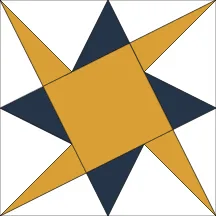
The Save as PDF option is available in all the print preview windows. It’s most useful for the Templates and Foundations print options where you can customize the printouts by moving and rotating pieces.
- In the Block Toolbar, click Print > Templates.
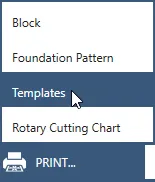
- In the Print Templates window, you can select the settings for your printout. I’ll be using the Default block size, as well as the default settings for all the other options. You can change any of these settings you’d like.
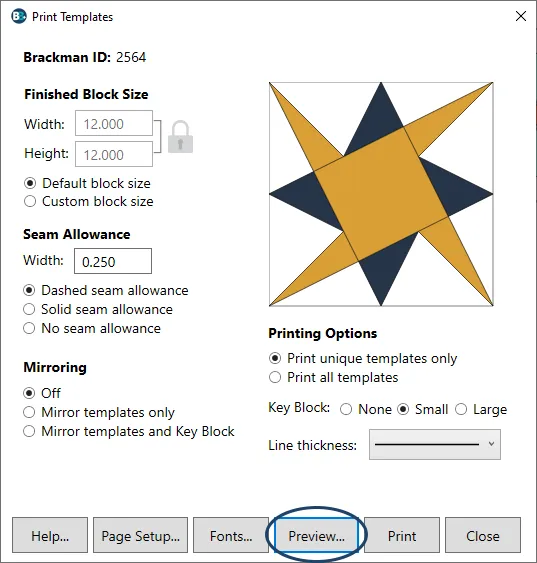
- Click the Preview button.
- In the print preview screen, check the box for 1″ Scale Square.
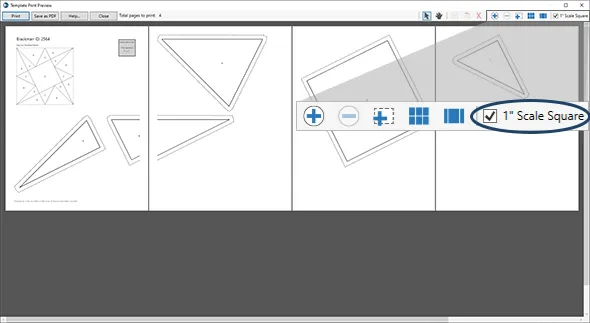
- Drag and rotate the templates in the preview for the best fit on the pages.
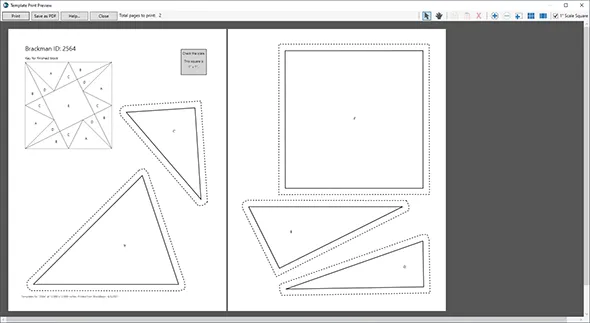
- Click the Save as PDF button.

- A Save window will appear. By default, the file will be named the Brackman ID. If you’d like to change it, you can type a new name.
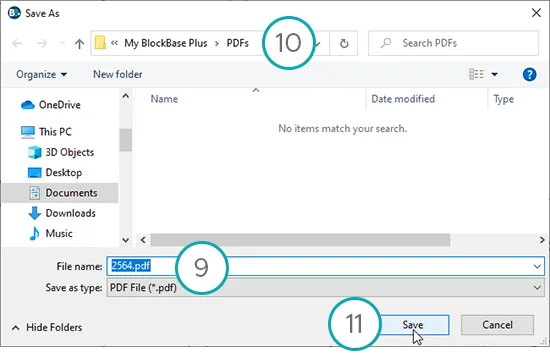
- PDF files from BB+ are saved in this directory on your computer: Documents > My BlockBase Plus > PDFs. You can change the save location, if you’d like. (I’m using a Windows computer for these illustrations. If you’re using a Mac, your Save window will look a little different, but the default save location will be the same as Windows.)
- Click the Save button. A PDF file will be created of this templates printout.
- Click Close in the print preview, then click Close in the Print Templates window.
- Now, let’s take a look at where that PDF file was saved. On your computer (outside of the BlockBase+ software), navigate to your Documents folder.
- In your Documents folder, open the folder called My BlockBase Plus, then open the folder called PDFs.
- In the PDFs folder, you should see the the file we saved (along with any other PDFs you’ve saved from BB+).
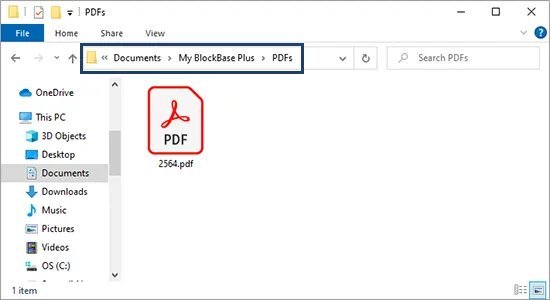
- If you double-click on the PDF file, it will open in your PDF reader software. Whenever you print a PDF file, it’s very important to check the size settings before printing. Make sure Actual size or 100% is selected. Always a good idea to measure that 1″ square after printing too!
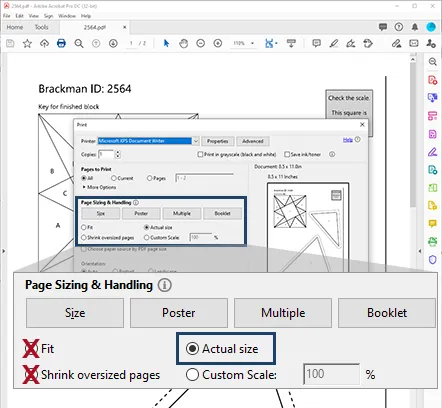
The advantage of using the Save as PDF option to create a PDF file of the printout, rather than simply printing, is that you only have to do the work of moving and rotating the patches in the print preview once. If it’s a block that you think you’ll want to print over and over again, you can simply print from the PDF file and not go through the print preview steps each time. - Close the PDF reader window, and the file explorer window, and go back to the BB+.
- Time to add this block to Favorites. With block 2564 still selected in the Block Viewer, click Add to Favorites in the Block Toolbar.

- At the top of the Navigation panel, click the Favorites button.
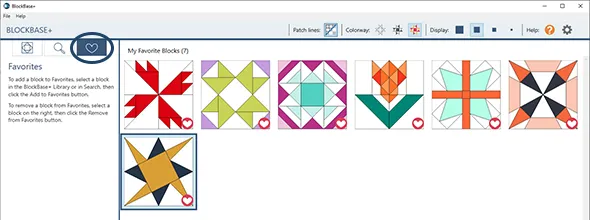
- Now you’ll see our seven Sew Along blocks in the Favorites view. If you want to come back later and print a different pattern for this block, you can quickly find it here in the Favorites.
- If you’re done working in BlockBase+, you can close the program by clicking the X at the top or clicking File > Quit BlockBase+.
Notes Before You Start Sewing:
- You can make the block any size you like. I’m making this block at the default 12″ size.
- You can be creative in your coloring of the block. Just keep the seams/patches in the same orientation as the BB+ block.
- For help with any of the printouts, visit our support site.
- There will be a new post here on the blog on Friday, July 2 where you can post a photo of your sewn 2564 block.
Comments
Let’s get to know each other in the comments! I love reading everyone’s comments! Here’s the question for this post:
Controversial topic this time! ![]() Do you always pre-wash your fabrics or never pre-wash before you start piecing? Or are you somewhere in between?
Do you always pre-wash your fabrics or never pre-wash before you start piecing? Or are you somewhere in between?
My answer: I have to admit that I rarely pre-wash my fabrics. It’s due to a combination of usually working with scraps, and impatience. When I’m ready to sew, I don’t want to take the time to pre-wash before I start!
Block 7 Video
The steps in the video are the same as the steps listed above. So you can follow the written steps above, or watch the video lesson for Block 7.


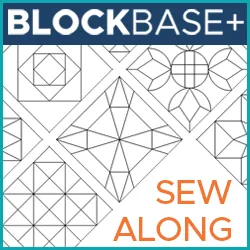


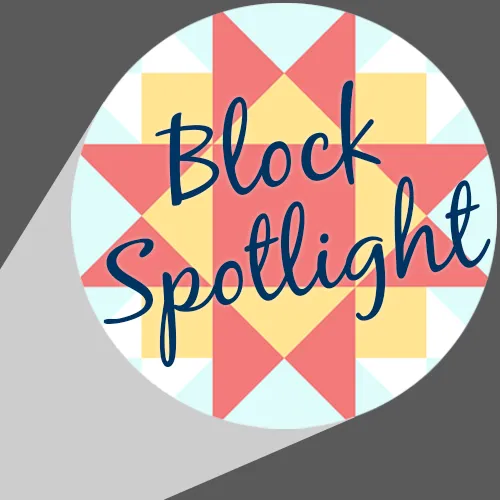

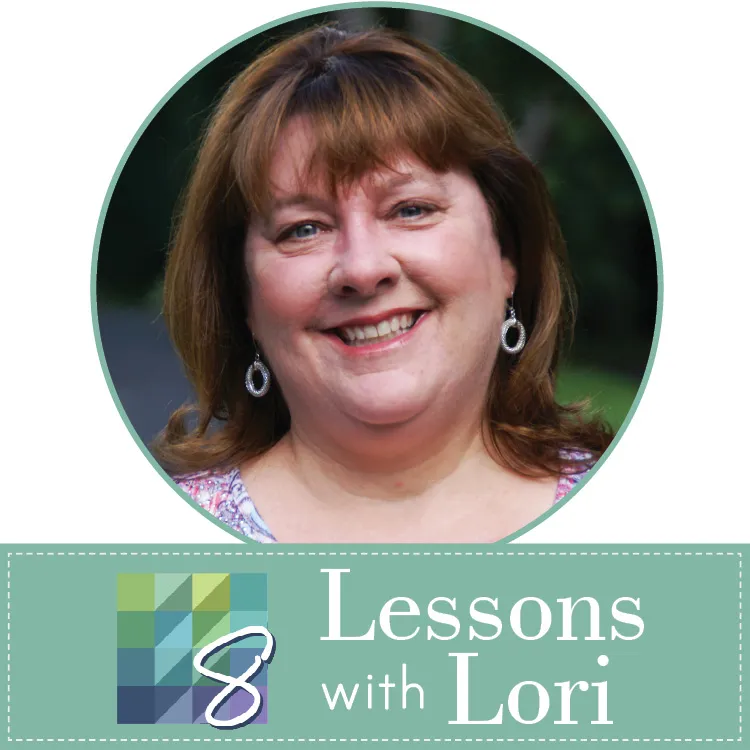
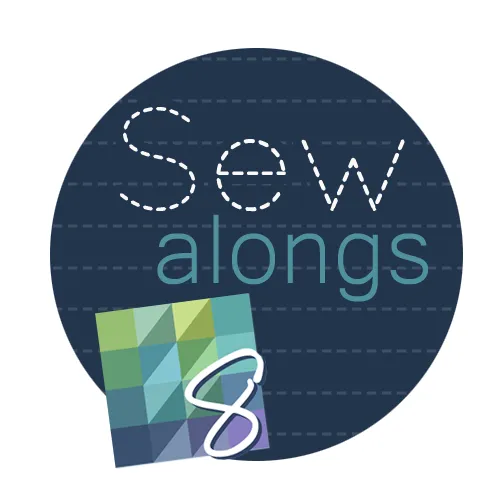
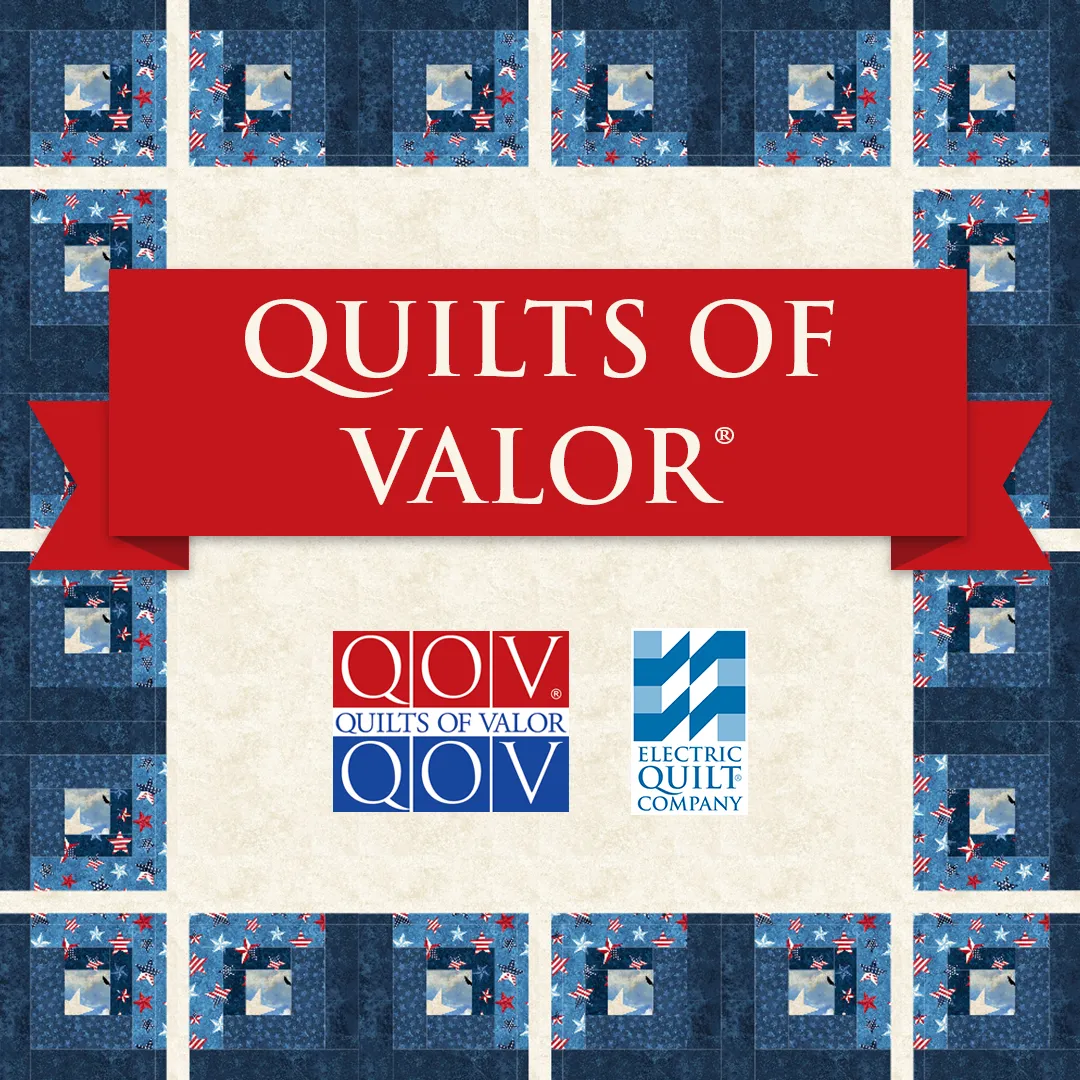
06-21-2021
11:20 am
My rule for myself is that if I have one fabric in my quilt that is pre-washed then they all must be. I prefer my shrinkage to be uniform when the quilt is done and washed. I do a lot of scrappy quilts so tend not wash as small pieces get eaten up.
06-21-2021
11:31 am
I prewash fabrics that I buy to use in baby quilts that we occasionally make. But I always have trouble ironing the fabric afterwards without distorting the grain. For example, stripes never seem to be straight after washing and ironing. Any suggestions? However, for my art quilts, I do not prewash, since the quilts will never be washed when completed. I find the little extra stiffness in the fabrics make it easier to work with.
06-21-2021
6:36 pm
Not sure this will help but when I press fabric yardage, I spray it with starch/sizing first then rub my hand over it to help to soak it in, or put the fabric face to face to accomplish the same thing (depends on how big the piece is). Then iron with a dry iron from cut edge to cut edge (the straight of grain) not from selvage to selvage. Sometimes “ironing” from selvage to selvage distorts the fabric. Using a light hand with the iron seems to give a better result.
If wrinkles in the fabric are stubborn, I use Flatter which is a fabric relaxer and so far it consistently works for this.
06-26-2021
1:48 pm
Thanks, Linda. You definitely addressed my problem. Who would’ve thought that I’d been ironing the wrong way all this time! Thanks.
06-21-2021
11:59 am
I am somewhere in between depending on my patience to get started but then I run into that question have I washed or not.
Jenny sorry that I did not read the comments above the Leave a Comment seection last Friday until after I posted. All of my questions were answered in those comments.
06-21-2021
12:10 pm
I inherited fabric from my Aunties and neighbors and am a scrappy quilter. As fabrics come in, I press it right away, but don’t iron until I’m ready to use it. Most of my quilts will see heavy use so it lessens potential problems with laundering.
06-21-2021
12:38 pm
I am a pre-wash gal, for multiple reasons. Firstly, I don’t relish putting a hot iron to an unwashed piece of fabric – there are multiple steps of chemical treatment in the fabric-processing, and I don’t wish to inhale any of it. Unwashed fabric has a slickness to it; washed, the fibers fluff up and cling to each other better. My points come out more precise and the fabric doesn’t “slip” underneath the presser foot as much. And lastly, Jo Morton (during a lecture I attended) talked about this point: the warehouses this finished fabric is stored in before shipping aren’t exactly the cleanest….Jo advises washing all new fabric even just for this cleanliness factor. Fat quarter sized and upwards of yardage go right to my washer/dryer when brought home from the quilt shop. Charms, jelly rolls I don’t try to prewash; that’d be a mess.
06-21-2021
2:07 pm
I have been making mine 12′ inch coordinating 3 in color and putting them together for a table runner. I find them a nice challenge.
06-21-2021
2:07 pm
I do not prewash any of my fabrics. I like the sizing to keep them crisp for easier cutting and sewing. If not crisp enough, I use a linen spray or light starch, especially if any edges will be bias.
06-21-2021
2:57 pm
I don’t like washing my fabrics so I don’t usually do it. A lot of the above comments may have changed my mind however. I did learn a good tip and that is cutting a small triangle off of each corner so the fabric doesn’t fray while washing. It makes it much easier to work with.
06-21-2021
3:03 pm
With the exception of the precuts less than fat quarters and scrappy pieces, I prewash fabric. Although even with precuts, sometimes I will test dark colors.
My experience with sewing new unwashed fabrics is that the sizing makes my eyes itchy and makes me sneeze! My other experience, which is the bigger reason for prewashing, is one of completing a quilt of many hours that bled the reds and blues when washed. Yikes! I always wash with Color Catchers and if I see it’s fabric that will bleed I use hot, hot water and Synthrapol and rinse/rinse with hot water. Interestingly, in our minds we think of bleeding fabric as “cheap” fabric, but this is not the case. Recently I used a wet Qtip to remove a water soluble marking on expensive fabric which I had prewashed with Synthrapol and the fabric bled onto the Qtip! Luckily I saw it happening and was careful not to pull the bleed into the adjacent white fabric.
As soon as I receive new fabric I wash & dry, starch and iron it. The extra effort is worth my peace of mind. If fabric continues to bleed, now I throw it out–as I don’t want to pass the issue to an unsuspecting scrapper.
06-21-2021
5:20 pm
I usually don’t pre-wash. However, the above comments have given me food for thought.
06-21-2021
10:31 pm
I NEVER prewash (nope, not even reds). I’m way too impatient and really, really hate to iron unless I’m pressing a seam. To be fair, most of my quilts are small and end up on the wall. But, I have occasionally had problems when blocking some larger quilts for gifts. Can you spell S-Y-N-T-H-R-O-P-O-L?
06-22-2021
5:36 pm
I am late on block 6, Life took over. but I will catch up and post block 6 in a day or two.
As for pre wash…mostly not! I’m too lazy and impatient. On occasion (not very often) I will prewash a red or dark blue especially if the quilt has a lot of white, but I use a color catcher when I wash the quilt and inform the recipient to do the same. I only use cold water. I am also known to throw in a handful of salt when I wash the quilt.
My mother always said to washed new garments with salt to set the colors. So I still do that now with my quilts and new garments. I don’t know if that is a wives tale. But, after they are washed the 1st time I seldom have any bleeding.
Does anyone else use salt?
06-23-2021
10:58 pm
I use salt and vinegar to clean my copper bottom pots but never heard of the salt trick to set fabric color. It’s probably true, so many things salt can do.
06-22-2021
6:36 pm
I prewash almost all fabric. I wash the fabric in zippered net bags (lingerie bags) to keep the edges from distorting & fraying too much. I use color catchers but if I have a dark fabric, I put a small piece of it in a jar of water overnight to see if it bleeds. For needle turn appliqué, I like the way washed fabric makes a better crease.
06-28-2021
9:55 pm
I very seldom pre-wash. The couple of times I made a minky-backed quilt, I did prewash the cottons, but not the minky.
Jamie Wallen recommends prewashing all backing fabric even if you haven’t prewashed the quilt-top fabrics. It relaxes the fabric enough so that you’re less likely to get tufts of batting poking through the backing. I just finished a quilt that had really densely woven backing fabric and I wished I’d follwed his advice, but it wasn’t really anything major, however.